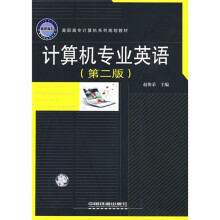CHAPTER 1 INTRODUCTION TO COMPUTERS
1.1 Computer Literacy
1.2 What Is a Computer and What Does It Do
1.3 The Components ofa Computer
1.3.1 Input Devices
1.3.2 Output Devices
1.3.3 System Unit
1.3.4 Storage Devices
1.3.5 Communication Devices
1.4 Computer Software
1.4.1 System Software
1.4.2 Application Software
1.5 Networks and the Internet
1.6 Categories ofComputers
1.6.1 Personal Computers
1.6.2 Minicomputers
1.6.3 Mainframe Computers
1.6.4 Super Computers
1.7 Examples ofComputers Usage
1.7.1 Home Users
1.7.2 Small Business Users
1.7.3 Mobile Users
1.7.4 Large Business Users
1.7.5 Power Users
The Characteristics of Science and Technology English
Reading Materials.
Computers in Everyday Life
SUMMARY
CHAPTER 2 THE INTERNETAND WORLD WIDE WEB
2.1 How the Internet Works
2.1 1 Connecting to the Intemet
2.1.2 Access Providers.
2.1.3 How Data Travels the Internet
2.1.4 Internet Addresses
2.2 The W0rld Wide Web(www)
2.2.1 Browsing the Web
2.2.2 Web Addresses
2.2.3 Navigating Web Pages
2.2.4 Searching For Information on the Web
2.3 Types ofWeb Sites
2.3.1 Portal
2.3.2 News
2.3.3 Informational
2.3.4 Business/Marketing
2.3.5 Educational
2.3.6 Entertainment
2.3.7 Advocacy
2.3.8 Blog
2.3.9 Content Aggregator
2.3.10 Personal
2.3.11 Wiki
2.3.12 Evaluating a Web Site
The Quality Criteria and Basic Method of Science and
Technology English Translation
Reading Materials
Other Internet Services
SUMMARY
CHAPTER 3 THE COMPONENTS IN THE SYSTEM UNIT
3.1 The System Unit
3.2 Central Processing Unit
3.2.1 The Control Unit
3.2.2 Arithmetic/Logic Unit
3.2.3 RegiSters
3.3 Microprocessor
3.1.1 Microprocessor Comparison
3.3.2 Parallel Processing
3.3.3 Coprocessor
3.4 Data Representation
3.4.1 ASCII
3.4.2 EBCDIC
3.4.3 Unicode
3.5 Different Types of Memory
3.5.1 RAM
3.5.2 ROM
3.5.3 Flash Memory
3.5.4 CMOS
3.5.5 Memory Access Times
3.6 Expansion Slots and Expansion Boards
3.7 How Is a Serial Port Different from a Parallel Port
3.7.1 Serial Port
3.7.2 Parallel Port
Word Building of Professional Computer English
Reading Materials
Emerging Technologies
SUMMARY
GHAPTER 4 INPUT
4.1 What Is Input
4.2 What Are Input Devices
4.3 The Keyboard
4.4 Pointing Devices
4.4.1 Mouse
4.4.2 Trackball
4.4.3 Touchpad
4.4.4 Stick
4.4.5 Joystick
4.4.6 Touch Screen
4.4.7 Pen Input
4.4.8 Light Pen .
4.4.9 Graphics Tablet
4.5 Scanners and Reading Devices
4.5.1 Optical Scanner
4.5.2 Optical Readers
4.6 Digital Cameras
Several Relations and the phenomenon of word addition in Science and
Technology English Translation
Reading Materials
Audio and Video Input
SUMMARY
CHAPTER 5 OUTPUT
5.1 What Is Output
5.2 What Are Output Devices
5.3 Display Devices
5.3.1 CRT Monitors
5.3.2 Flat-Panel Displays
5.3.3 Monitor Quality
5.3.4 Video Cards
5.4 Printers
5.4.1 Impact Printer
5.4.2 Nonimpact Printer
The Translation Method of Passive Voice
Reading Materials
Audio Output, Terminals and Other Output Devices
SUMMARY
CHAPTER 6 STORAGE
6.1 Memory
6.2 Types of Storage
6.3 Floppy Disks
6.3.1 Characteristics of Magnetic Media
6.3.2 Characteristics of a Floppy Disk
6.4 USB Flash Drive
6.5 Hard Disk
6.5.1 Characteristics of a Hard Disk
6.5.2 How dose a Hard Disk Work
6.5.3 Maintaining Data Stored on a Hard Disk
The Translation Method of Noun Clause
Reading Materials.
Compact Discs, Tapes, PC Cards and Other Types of Storage
SUMMARY
CHAPTER 7 COMMUNICATIONS AND NETWORKS
7.1 Communications
7.2 How Is Communications Used
7.3 Communications Channel
7.4 Physical Transmission Media
7.4.1 Twisted-Pair Cable
7.4.2 Coaxial Cable
7.4.3 Fiber-Optic Cable
……
CHAPTER 8 OPERATING SYSTEM
CHAPTER 9 DATABASE
CHAPTER 10 CATEGORIES OF SOFTWARE AND PROGRAMMING LANGUAGES

 缺书网
缺书网 扫码进群
扫码进群






